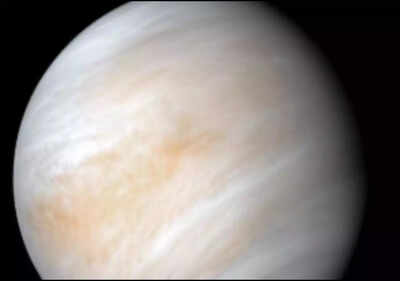- News
- Science News
- Venus's water mystery: Could a simple molecule be the culprit?
Venus's water mystery: Could a simple molecule be the culprit?

NEW DELHI: Venus, often described as Earth's twin due to its similar size and mass, presents a stark contrast to our planet in terms of water content. Scientists have long been intrigued by the mystery of how Venus, which likely once harbored significant amounts of water, has evolved into the dry, scorching planet we observe today. Recent research highlights a potential culprit behind Venus's disappearing water: the molecule formyl cation, or HCO+.
HCO+, which consists of hydrogen, carbon, and oxygen atoms, is thought to play a crucial role in the escape of hydrogen atoms into space from Venus's atmosphere. The process involves the molecule reacting and breaking apart in the presence of electrons, which leads to the loss of hydrogen atoms—the essential component of water (H2O). This molecular activity suggests that Venus is still losing water, even though it retains only a tiny fraction of the water compared to Earth, a report in Earthsky said.
Understanding the role of molecules like HCO+ in atmospheric chemistry is vital for comprehending the broader aspects of planetary evolution. It helps scientists piece together the atmospheric history of Venus and theorize about its climatic changes over billions of years. Moreover, this research has implications for the study of exoplanets, especially those that orbit close to their host stars where similar atmospheric phenomena might occur.
The continued exploration of Venus by missions such as DAVINCI and VERITAS is expected to provide more detailed data on the presence and concentration of HCO+ and other critical molecules in its atmosphere. These missions aim to directly sample the atmospheric layers of Venus, offering more definitive answers about the chemical processes at play and their impact on the planet’s water history.
HCO+, which consists of hydrogen, carbon, and oxygen atoms, is thought to play a crucial role in the escape of hydrogen atoms into space from Venus's atmosphere. The process involves the molecule reacting and breaking apart in the presence of electrons, which leads to the loss of hydrogen atoms—the essential component of water (H2O). This molecular activity suggests that Venus is still losing water, even though it retains only a tiny fraction of the water compared to Earth, a report in Earthsky said.
Understanding the role of molecules like HCO+ in atmospheric chemistry is vital for comprehending the broader aspects of planetary evolution. It helps scientists piece together the atmospheric history of Venus and theorize about its climatic changes over billions of years. Moreover, this research has implications for the study of exoplanets, especially those that orbit close to their host stars where similar atmospheric phenomena might occur.
The continued exploration of Venus by missions such as DAVINCI and VERITAS is expected to provide more detailed data on the presence and concentration of HCO+ and other critical molecules in its atmosphere. These missions aim to directly sample the atmospheric layers of Venus, offering more definitive answers about the chemical processes at play and their impact on the planet’s water history.
The study of Venus not only illuminates the past of our neighboring planet but also serves as a proxy to understand other rocky planets in the cosmos. These insights are crucial for astrobiology and the search for life beyond Earth, offering clues about the conditions that might support life or lead to its absence.
End of Article
FOLLOW US ON SOCIAL MEDIA

